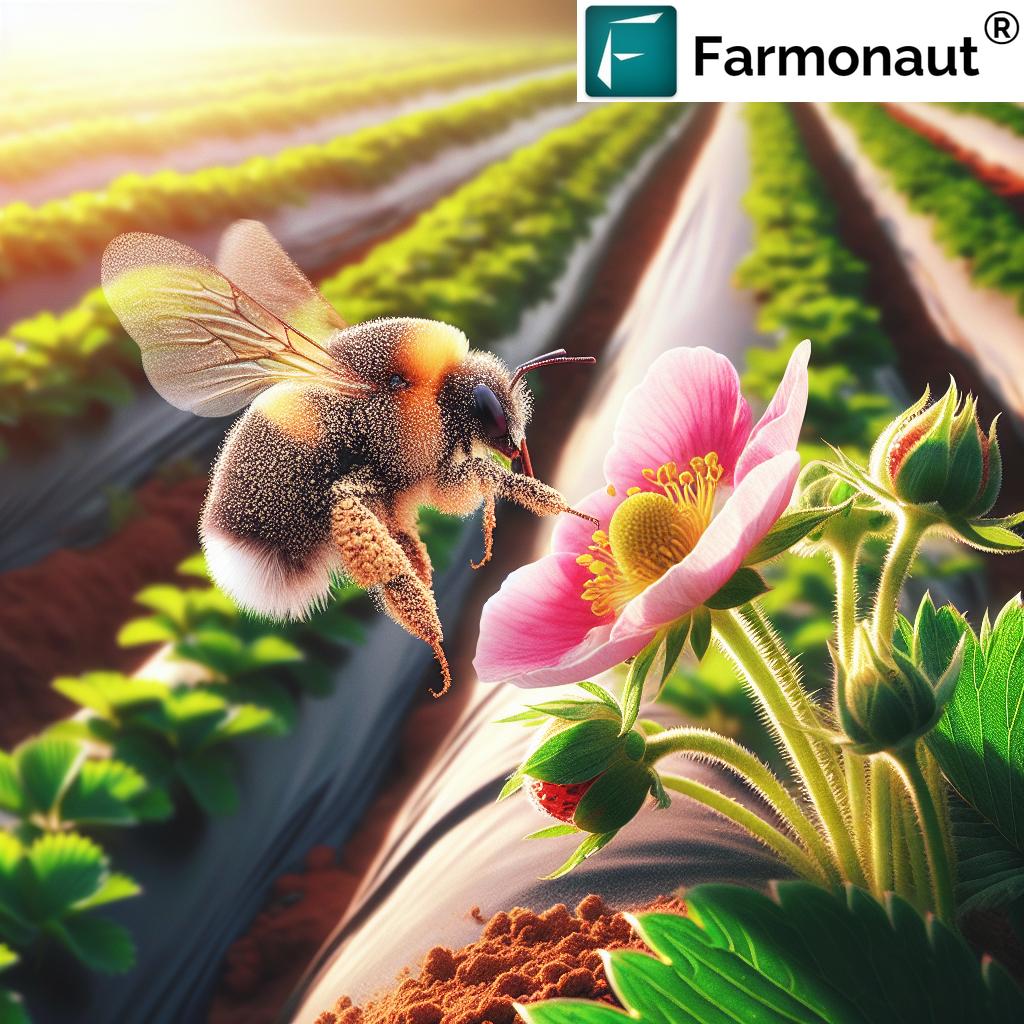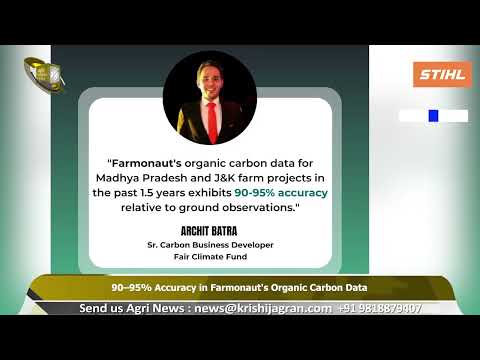Revolutionizing Organic Pest Control: How Bumblebees Are Transforming Crop Management in Ontario
“Bumblebees can deliver natural pesticides to up to 10,000 flowers per day using bee vectoring technology.”
In the heart of Ontario, Canada, a quiet revolution is taking place in the world of agriculture. We’re witnessing the dawn of a new era in organic pest control for crops, where nature’s own pollinators are becoming the unlikely heroes in our fight against crop diseases and pests. This innovative approach, known as bee vectoring technology, is not just transforming how we manage our crops; it’s reshaping our entire understanding of sustainable agriculture.
At Farmonaut, we’re excited to explore this groundbreaking technology that’s creating buzz in the farming community. As pioneers in agricultural technology, we recognize the potential of this eco-friendly solution to address some of the most pressing challenges faced by farmers today.
The Buzz About Bumblebees: Nature’s New Pest Control Agents
Imagine a world where bumblebees are not just pollinators but also protectors of our crops. This is no longer a fantasy but a reality unfolding in the fields of Ontario and beyond. Bumblebee pollination technology is at the forefront of sustainable agriculture solutions, offering a natural and effective way to combat crop diseases and pests.
Here’s how it works: As bumblebees leave their hives to forage, they pass through a specially designed tray containing a powder made of organic, beneficial fungi or other natural pesticides. This powder sticks to their fuzzy bodies, and as they visit flowers, they deposit tiny amounts of this protective substance directly onto the plants. It’s a precision delivery system that nature has perfected over millions of years.

The Benefits of Bee Vectoring: A Game-Changer for Farmers
The advantages of this innovative crop disease management technique are numerous and significant:
- Precision Application: Bees deliver the protective agents exactly where they’re needed – on the flowers.
- Continuous Protection: As bees work tirelessly throughout the blooming period, crops receive ongoing protection.
- Reduced Chemical Use: This method significantly decreases the need for traditional pesticide spraying.
- Water Conservation: Unlike spraying, bee vectoring doesn’t require water for application.
- Environmentally Friendly: It minimizes chemical runoff and supports bee populations.
These benefits align perfectly with the growing demand for eco-friendly farming practices and organic produce. As we at Farmonaut strive to make precision agriculture more accessible, we see bee vectoring as a complementary technology that can enhance sustainable farming practices.
The Science Behind the Buzz
The effectiveness of bee vectoring in agriculture lies in its ability to harness the natural behavior of bees. Bumblebees, in particular, are ideal for this task due to their large size, fuzzy bodies, and foraging habits. They can carry more of the protective powder and are active in cooler temperatures, making them suitable for a wide range of crops and climates.
The natural pesticide delivery systems used in bee vectoring often contain beneficial fungi like Clonostachys rosea. This fungus competes with harmful pathogens like Botrytis cinerea, which causes gray mold in many fruit crops. By introducing these beneficial microorganisms directly to the flowers, bee vectoring creates a protective shield around the developing fruit.
Crop-Specific Applications: From Strawberries to Sunflowers
The versatility of bee vectoring technology is one of its most impressive aspects. It’s being successfully applied to a wide range of crops, including:
- Strawberries: Protecting against Botrytis and improving fruit quality.
- Blueberries: Enhancing pollination and reducing fungal diseases.
- Apples: Improving fruit set and combating storage rots.
- Sunflowers: Boosting seed production and oil content.
- Tomatoes: Enhancing yield and reducing blossom-end rot.
- Canola: Increasing seed production and oil quality.
In Ontario, where diverse crops thrive, bee vectoring is proving to be a versatile tool in the farmer’s arsenal. It’s particularly effective in high-value crops like strawberries and blueberries, where quality is paramount and chemical residues are a concern.
“Bee-delivered pest control can reduce chemical pesticide use by up to 80% compared to traditional spraying methods.”
Comparing Bee Vectoring to Traditional Pesticide Application
To fully appreciate the revolutionary nature of bee vectoring, let’s compare it to traditional pesticide spraying methods:
| Aspect | Bumblebee Vectoring Technology | Traditional Pesticide Spraying |
|---|---|---|
| Application Precision | Targeted delivery to flowers | Broad application, less precise |
| Environmental Impact | Minimal, supports bee populations | Potential for runoff and non-target effects |
| Pesticide Usage Efficiency | High, minimal waste | Lower, with potential for overspray |
| Crop Coverage | Continuous throughout bloom period | Intermittent, based on spray schedule |
| Cost-Effectiveness | Initially higher setup, lower long-term costs | Lower initial costs, higher ongoing expenses |
| Pollination Benefits | Dual benefit: pest control and pollination | No pollination benefit |
| Worker Safety | High, minimal human contact with pesticides | Potential exposure risks during application |
| Residue on Produce | Minimal to none | Potential for residue |
| Pest Resistance Management | Lower risk of resistance development | Higher risk of pest resistance over time |
| Organic Certification Compatibility | Highly compatible with organic practices | Limited options for organic certification |
This comparison clearly illustrates the advantages of bee vectoring technology in creating a more sustainable and efficient pest management system.
The Ontario Connection: A Case Study in Innovation
Ontario, with its rich agricultural heritage and innovative spirit, has become a hotbed for bee vectoring technology. The province’s diverse crop base, from the sprawling apple orchards to the lush strawberry fields, provides an ideal testing ground for this revolutionary approach.
In Mississauga, Ontario, researchers and farmers are collaborating to fine-tune bee vectoring techniques for local conditions. They’re discovering that not only does this method provide excellent crop protection, but it also supports the local bee population, creating a win-win situation for agriculture and biodiversity.

The Role of Technology in Modern Farming
As we at Farmonaut continue to develop cutting-edge solutions for precision agriculture, we see bee vectoring as a perfect complement to our satellite-based crop monitoring systems. Our technology can help farmers optimize the placement of bee hives and monitor the effectiveness of bee vectoring across their fields.
For instance, our satellite imagery can identify areas of crop stress that might benefit from increased bee activity. By integrating this data with bee vectoring strategies, farmers can create a highly targeted and efficient pest management plan.
To learn more about how Farmonaut’s technology can enhance your farming practices, check out our web application or download our mobile apps:
The Future of Bee Vectoring: Challenges and Opportunities
While bee vectoring technology shows immense promise, it’s not without its challenges. Some of the hurdles that researchers and farmers are working to overcome include:
- Scalability: Ensuring sufficient bee populations for large-scale farming operations.
- Weather Dependence: Bees are less active in cold or rainy weather, which can affect vectoring efficacy.
- Regulatory Approval: Navigating the process of getting new biological control agents approved for use.
- Farmer Education: Training farmers in the proper management of bee vectoring systems.
Despite these challenges, the future of bee vectoring looks bright. As more farmers adopt this technology and researchers continue to refine the process, we can expect to see even greater benefits in terms of crop yield, quality, and environmental sustainability.
The Broader Impact: Beyond Pest Control
The adoption of bee vectoring technology has implications that extend far beyond pest control. It represents a shift towards more holistic and sustainable farming practices that can have wide-ranging benefits:
- Biodiversity Conservation: By supporting bee populations, this technology helps maintain crucial pollinator species.
- Food Security: Improved crop yields and quality contribute to more stable food supplies.
- Consumer Health: Reduced chemical residues on produce lead to healthier food options.
- Climate Resilience: Natural pest control methods can help crops withstand changing climate conditions.
At Farmonaut, we’re excited about the potential of integrating bee vectoring data with our satellite-based crop monitoring systems. This combination could provide farmers with unprecedented insights into their crop health and pest management strategies.
Embracing Innovation: The Path Forward
As we look to the future of agriculture, it’s clear that innovations like bee vectoring technology will play a crucial role in creating more sustainable and efficient farming systems. For farmers in Ontario and beyond, embracing these new technologies can lead to significant benefits:
- Reduced reliance on chemical pesticides
- Improved crop yields and quality
- Enhanced environmental stewardship
- Better alignment with consumer demands for organic produce
At Farmonaut, we’re committed to supporting farmers in their journey towards more sustainable and efficient farming practices. Our satellite-based crop monitoring technology can work hand-in-hand with bee vectoring systems to provide comprehensive crop management solutions.
For more information on how Farmonaut can support your farming operations, visit our web application or explore our API for custom integrations.
Conclusion: A Buzzing Revolution in Agriculture
The adoption of bee vectoring technology in Ontario represents a significant step forward in the realm of sustainable agriculture. By harnessing the natural behavior of bees, farmers are finding an effective, environmentally friendly solution to pest management that aligns perfectly with the principles of organic farming.
As we continue to face challenges such as climate change and the need for increased food production, innovative approaches like bee vectoring offer hope for a more sustainable future. At Farmonaut, we’re excited to be part of this agricultural revolution, providing farmers with the tools and insights they need to thrive in this new era of farming.
The buzz about bumblebees in Ontario’s fields is more than just noise – it’s the sound of a quieter, cleaner, and more efficient future for agriculture. As we move forward, let’s embrace these innovative solutions and work together towards a more sustainable and productive agricultural sector.
FAQs About Bee Vectoring Technology
- Q: Is bee vectoring technology safe for the bees?
A: Yes, the organic compounds used in bee vectoring are safe for bees and do not harm their health or behavior. - Q: Can bee vectoring be used in organic farming?
A: Absolutely! Bee vectoring is highly compatible with organic farming practices and can help maintain organic certification. - Q: How does bee vectoring compare in cost to traditional pesticide spraying?
A: While initial setup costs may be higher, bee vectoring can be more cost-effective in the long run due to reduced labor and pesticide costs. - Q: What types of crops benefit most from bee vectoring?
A: Bee vectoring is particularly effective for berries, tree fruits, and flowering vegetables, but research is expanding its application to a wider range of crops. - Q: How does weather affect bee vectoring effectiveness?
A: Bee activity is influenced by weather conditions, with optimal performance on warm, sunny days. However, bumblebees are more tolerant of cooler temperatures compared to honeybees.





